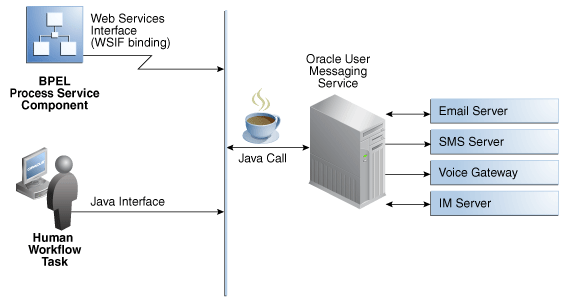Introduction to the Notification Service
Various scenarios may require sending email messages or other types of notifications to users as part of the process flow. For example, certain types of exceptions that cannot be handled automatically may require manual intervention. In this case, a BPEL process can use the notification service to alert users by email, IM, or SMS message.
The contact information (email address, phone number, and so on) of the recipient is either static (such as admin@yourcompany.com) or obtained dynamically during runtime. To obtain the contact information dynamically, XPath expressions can retrieve it from the identity store (LDAP) or extract it from the BPEL payload.
This chapter uses the following terms:
-
Notification
An asynchronous message sent to a user by a specific channel. The message can be sent as an email, IM, or SMS message.
-
Actionable notification
A notification to which the user can respond. For example, workflow sends an email to a manager to approve or reject a purchase order. The manager approves or rejects the request by replying to the email with appropriate content.
-
Human task email notification layer
Sends email notifications directly from a BPEL process or implicitly from the human task part of a BPEL process. Implicit notifications are modeled from the Human Task Editor.
For sending email notifications directly from a BPEL process, you must explicitly specify the user information in the BPEL process. You can be inside or outside of a human task scope.
For sending email notifications implicitly from the human task part of a BPEL process, you only specify the recipient based on the relationship of the user with regards to the task (that is, the creator, assignee, and so on).
Note:
Implicit notifications are processed through more layers of code than explicit notifications. If explicit notifications are functioning correctly, it does not mean that implicit notifications also function correctly.
-
Oracle User Messaging Service
The BPEL notification service uses the underlying infrastructure provided by Oracle User Messaging Service to send notifications.
Oracle User Messaging Service also provides the user preference infrastructure for getting the end user's preferred channel during runtime.
For more information on the Oracle User Messaging Service, see Developing Applications with Oracle User Messaging Service.
Figure 17-1 shows the Oracle User Messaging Service interfaces and supported service types.
Figure 17-1 Service Interfaces and Supported Service Types

Description of "Figure 17-1 Service Interfaces and Supported Service Types"
For more information about notifications, see the following sections:
-
Specifying Participant Notification Preferences for instructions on specifying email notifications in the Human Task Editor